Inpacts of nature of work, social environment and benefits on movivation of employees: The case of a public organization in britain
This study explored the impacts of nature of work, social environment and benefits on
employee motivation at the Environment Agency (EA) as responding to the continuous
public sector pay restraint, which has already been in place for seven years in Britain. A mix
methods of primary data collection was employed including a questionnaire survey
generating quantitative data, preceded by qualitative, semi-structured interviews. The
questionnaire was sent out to a sample of 500 employees selected from the National Office
group using stratified sampling technique. 197 people responded within two weeks, making a
response rate of 39.4%. The findings indicate that a more favourable attitude toward the
meaningfullness and worthiness of work as well as equality and recognition have significantly
positive impacts on employee’s (self-reported) motivation level. Recommendations based on
these findings are also provided.
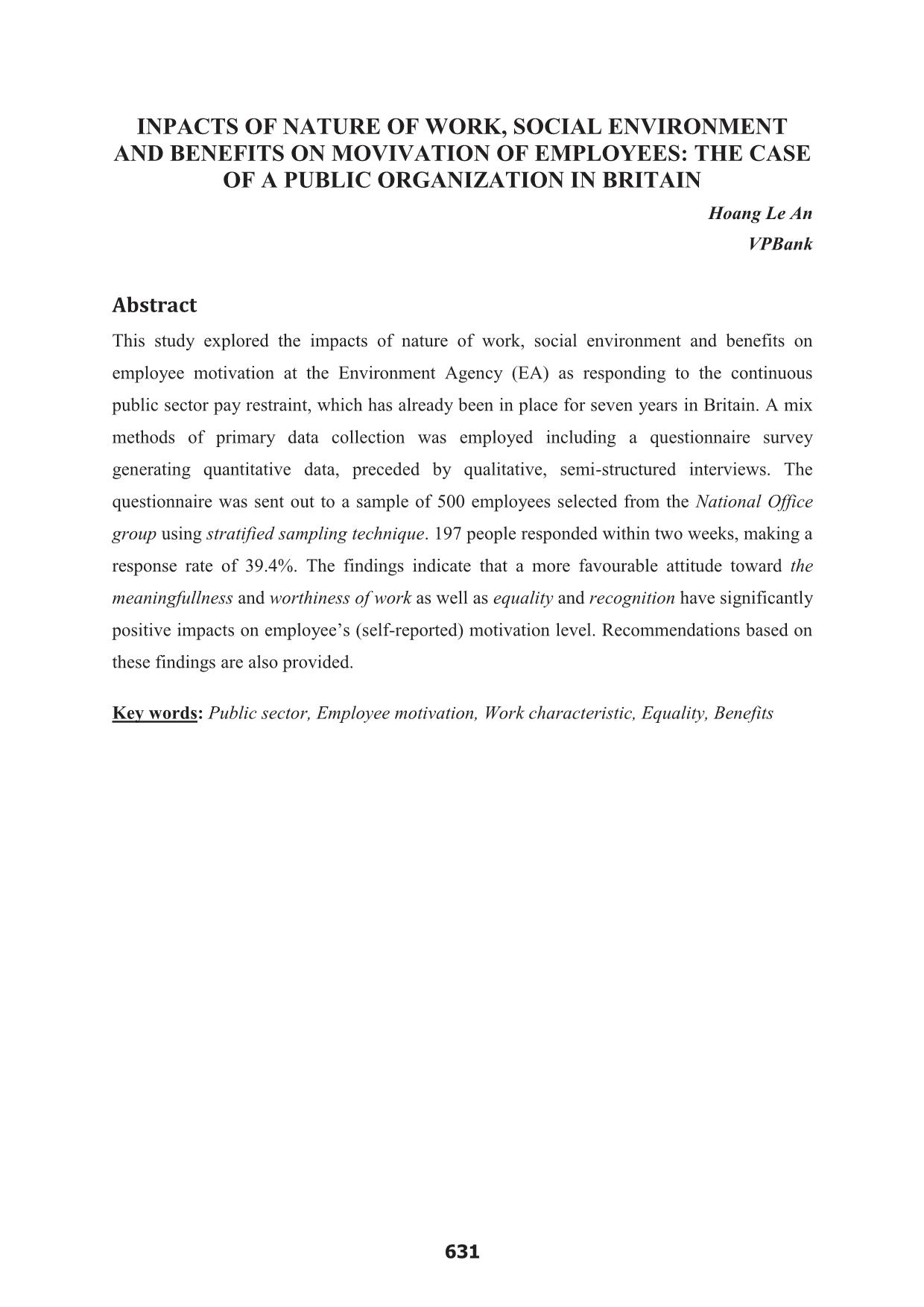
Trang 1
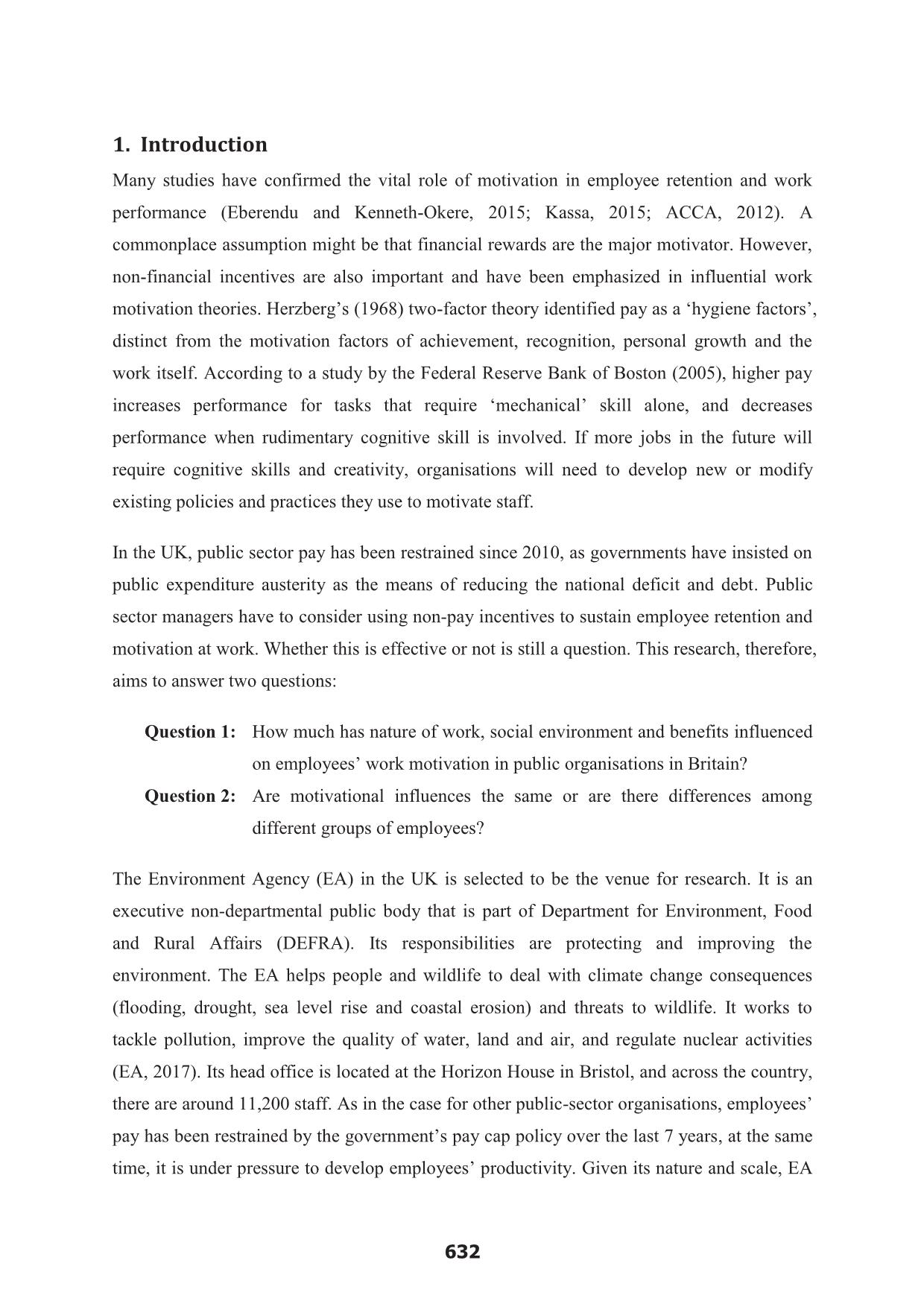
Trang 2
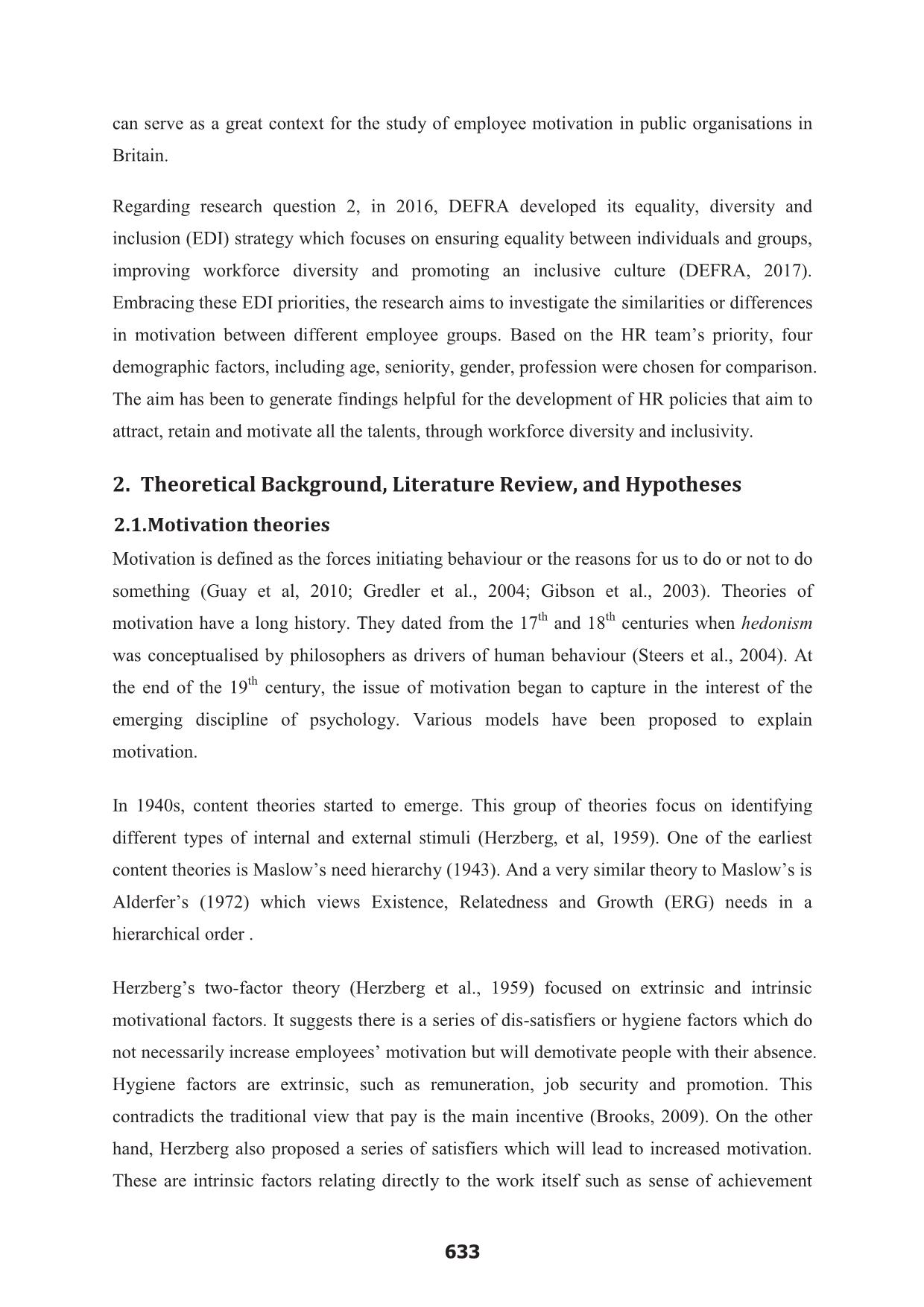
Trang 3

Trang 4
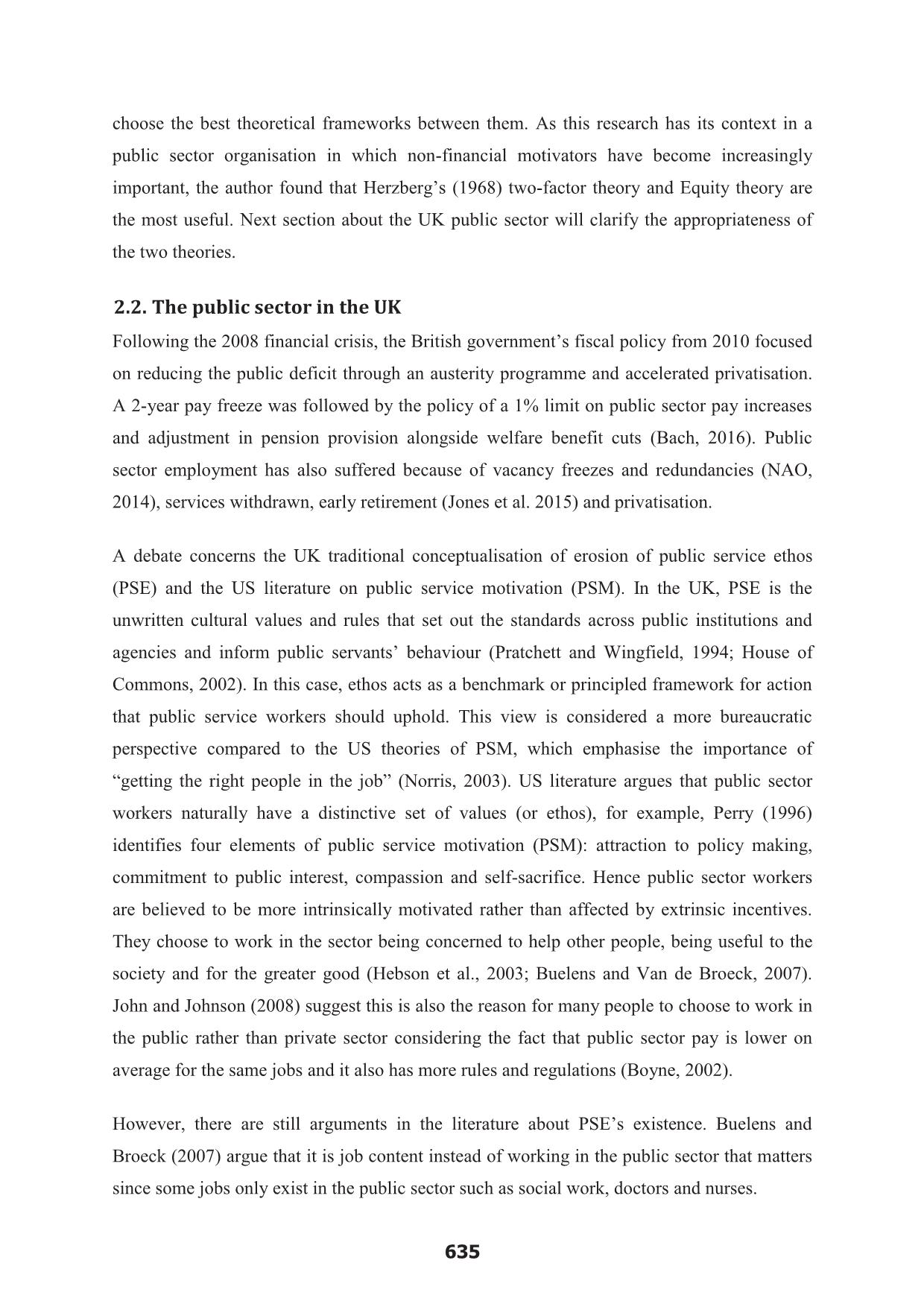
Trang 5
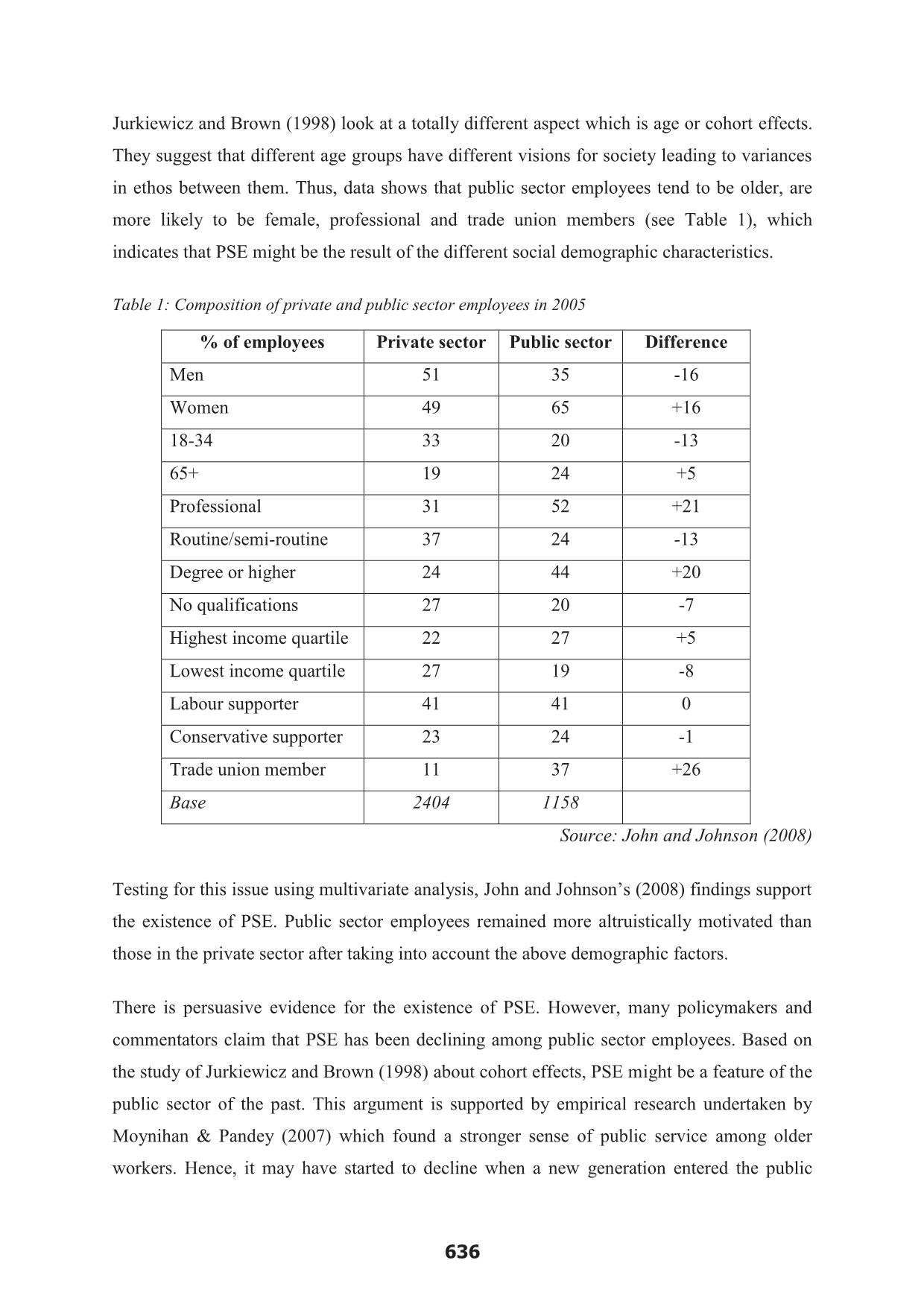
Trang 6
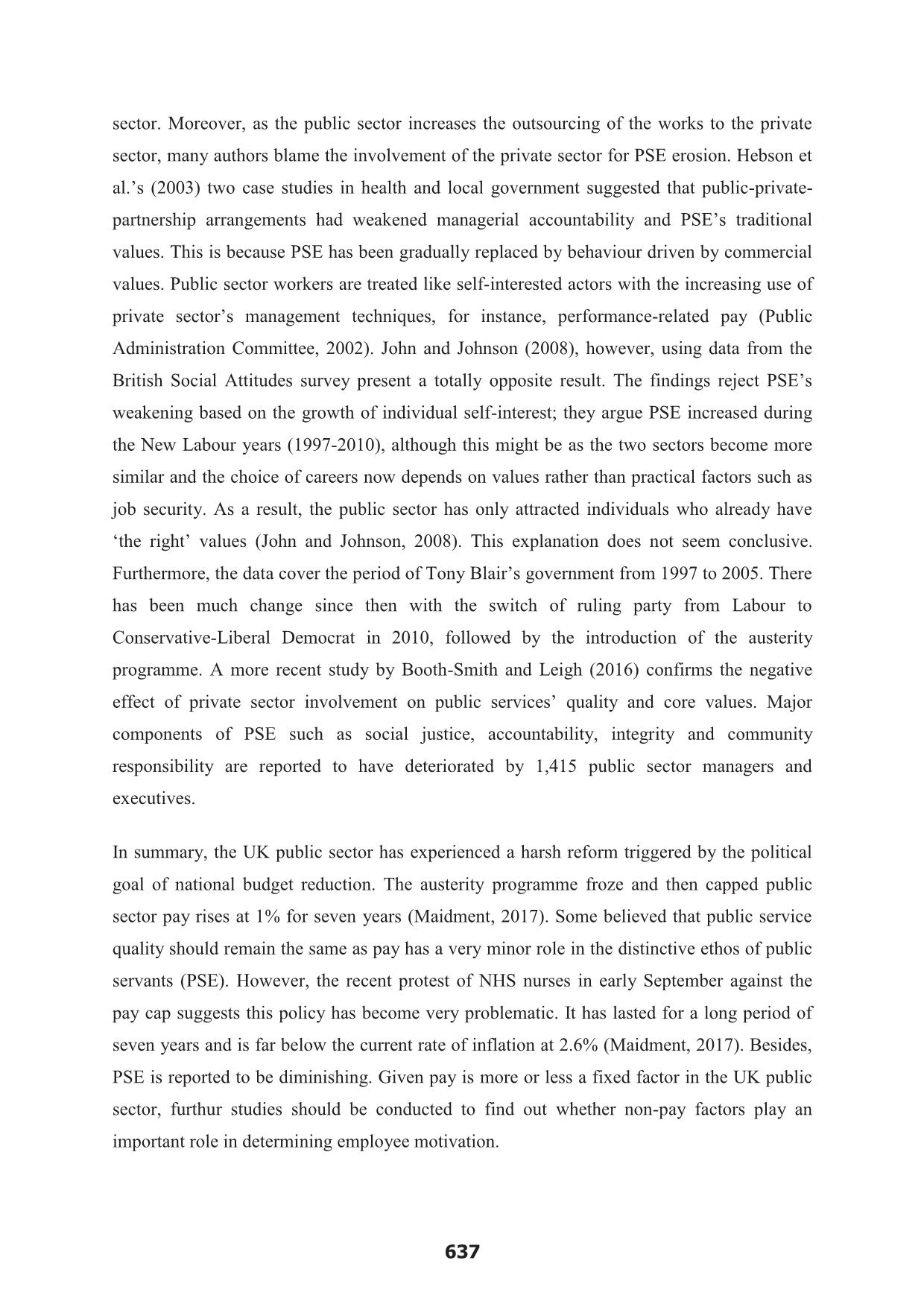
Trang 7

Trang 8
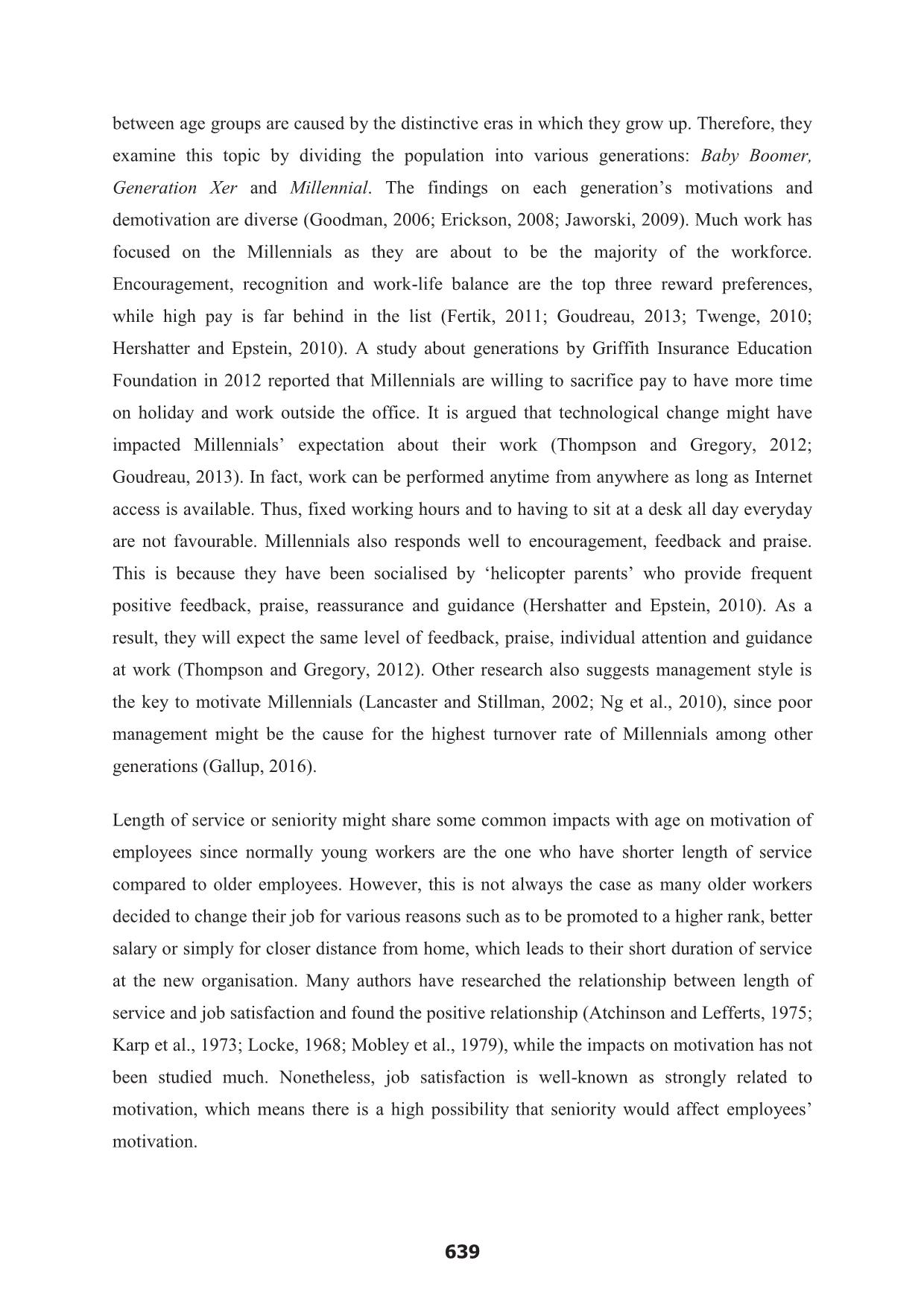
Trang 9
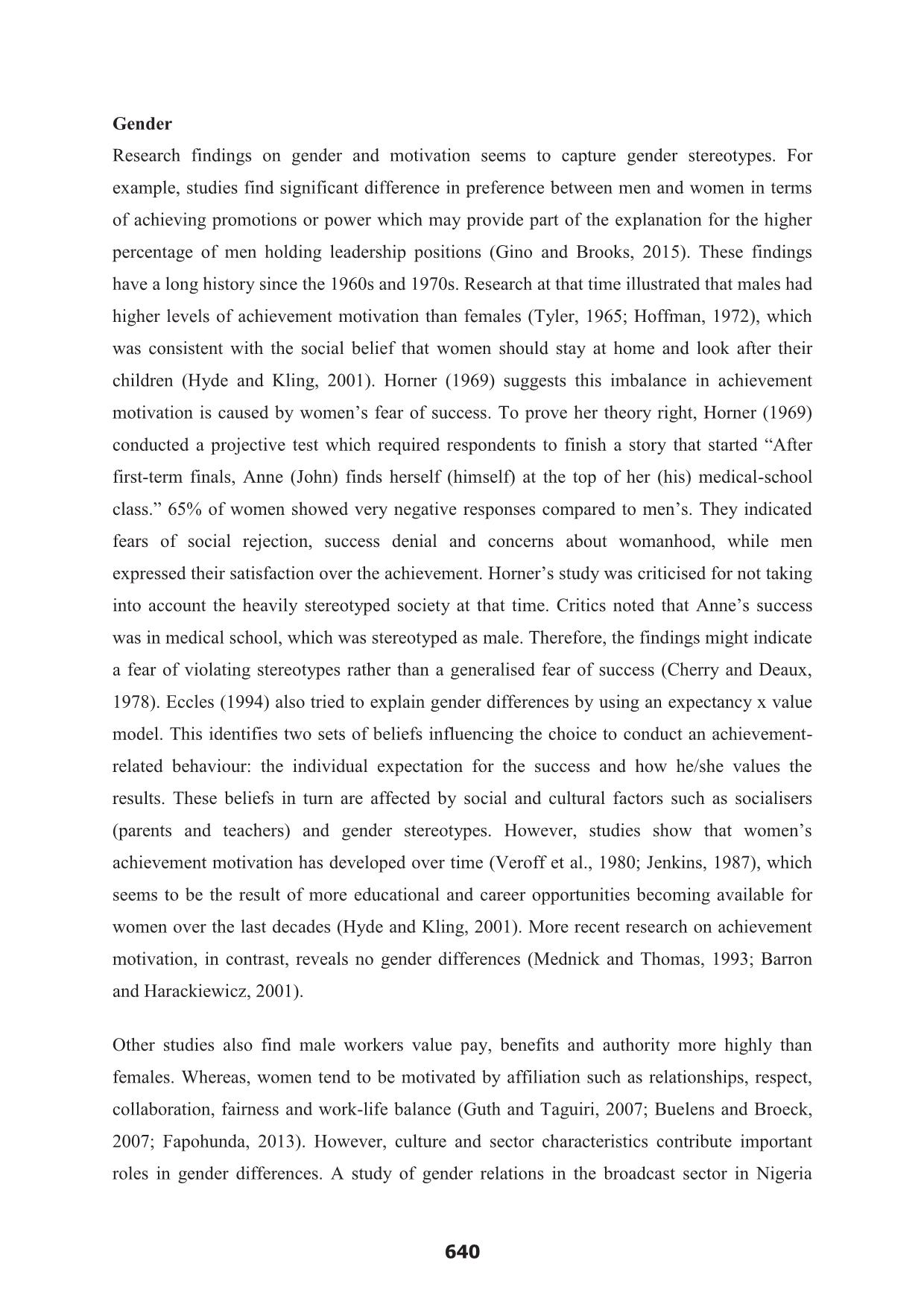
Trang 10
Tải về để xem bản đầy đủ
Tóm tắt nội dung tài liệu: Inpacts of nature of work, social environment and benefits on movivation of employees: The case of a public organization in britain
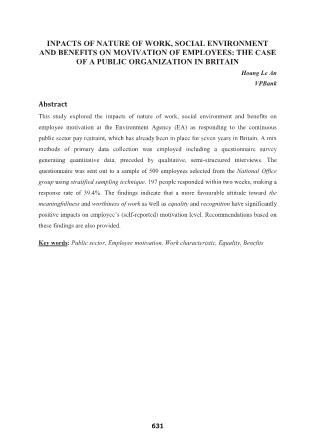
feel they are doing an interesting and meaningful work, management style is very important. Managers need to strive to allocate work that best aligns with their team members’ skills and interests. Investigating employees’ strengths and helping to develop them through appropriate goal setting and mentoring will create challenging and interesting work for employees. Likewise, giving employees the opportunities to choose the assignments matched their personal preferences and strengths is another way of promoting intrinsic motivation. Employees should also be included in decision-making process, which gives them a stake in the success of the organisation. They will feel valued as well as achieved something worthwhile. Thus, training for managers about the importance and conduct of those skills should be one of the key practices that drive employees’ motivation. In addition, organising outdoor days that allows office workers to participate in actual field works of helping the community environment will enhance their feeling about the importance of their contribution. 651 References ACCA (2012) Talent Attraction and Retention in Large Accounting Firms [online]. ACCA. Available from: PDFs/talent-attraction-singapore.pdf [Accessed 17 September 2017]. Adams, S. (1963) Toward an understanding of inequity. Journal of Abnormal and Social Psychology. 67, pp. 422-436. Al-Zawahreh, A. and Al-Maldi, F. (2012) The utility of equity theory in enhancing organisational effectiveness. European Journal of Economics, Finance and Administrative Sciences. 46, pp. 158-170. Bach, S. (2016) Deprivileging the public sector workforce: Austerity, fragmentation and service withdrawal in Britain. The Economic and Labour Relations Review. 27(1), pp. 11-28. Barron, K. and Harackiewicz, J. (2001) Achievement goals and optimal motivation: Testing multiple goal models. Journal of Personality and Social Psychology. 80, pp. 706–722. Blackburn, R. and Mann, M. (1979) The Working Class in the Labour Market. London: Macmillan. Booth-Smith, L. and Leigh, D. (2016) A New Public Service Ethos: Next Generation Public Service Reform [online]. Localis and Grant Thornton. Available at: kingdom/pdf/publication/2016/a-new-public-service-ethos.pdf [Accessed 06 September 2017]. Boyne, G. (2002) Public and private management: What is the difference? Journal of Management Studies. 39(1), pp. 97-122. Brooks, I. (2009) Organisational Behaviour. 4th ed. London: Pearson. Browne, K. (2013) Unique factors for motivating engineers: A motivation meta theory approach. Doctor of Business Administration. Available at: [Accessed 29 June 2017]. 652 Buelens, M. and Broeck, H. (2007) An analysis of differences in work motivation between public and private sector organisations. Public Administration Review. 67(1) pp. 65-74. Cherry, F. and Deaux, K. (1978) Fear of success versus fear of gender-inappropriate behaviour. Sex Roles. 4, pp. 97–102. De Lange, A., Yperen, N., Van der Heijden, B. and Bal, M. (2010) Dominant achievement goals of older workers and their relationship with motivation-related outcomes. Journal of Vocational Behaviour. 77(1), pp. 118-125. DeBeer, M. (1987) 'n Ondersoek na die rol wat arbeidsomset in die bedryf speel met spesifieke verwysing na werkbevrediging en werksmotivering. Master, University of the Free State. DEFRA (2017) Defra Group: Equality, Diversity and Inclusion Strategy 2017 to 2020 [online]. DEFRA. Available at: https://www.gov.uk/government/uploads/system/uploads/attachment_data/file/585990/defra- group-equality-diversity-and-inclusion-strategy-2017-to-2020.pdf [Accessed 18 September 2017]. Eccles, J. (1994) Understanding women’s educational and occupational choices: Applying the Eccles et al. model of achievement-related choices. Psychology of Women Quarterly. 18, pp. 585–610. The Environment Agency (EA) (2016) Environment Agency Annual report and accounts for the financial year 2015 to 2016 [online]. UK: The Environment Agency. Available from: https://www.gov.uk/government/uploads/system/uploads/attachment_data/file/538604/LIT_1 0494.pdf [Accessed 03 July 2017]. The Environment Agency (2017) The Work of the Environment Agency. Environment Agency. Eberendu, A. and Kenneth-Okere, R. (2015) An empirical review of motivation as a constituent to employees’ retention. Research Inventy: International Journal of Engineering and Science. 5(2), pp. 06-15. Erickson, T. (2008) Don’t treat them like baby boomers. Business Week. August, p. 64. 653 Fapohunda, T. (2013) An exploration of gender based differences in workplace values. International Journal of Human Resource Studies. 3(3), pp. 50-61. Federal Reserve Bank of Boston (2005) Large Stakes and Big Mistakes. Boston: Federal Reserve Bank of Boston. Fertik, M. (2011) Managing and motivating employees in their twenties. Harvard Business Review [online]. [Accessed 10 September 2017]. Gibson, J., Ivancevich, J., Donnelly, J. and Konopaske, R. (2003) Organisations: Behaviour, Structure, Processes. 11st ed. New York: McGraw-Hill/Irwin. Gino, F. and Brooks, A. (2015) Explaining gender differences at the top. Harvard Business Review. Available at: https://hbr.org/2015/09/explaining-gender-differences-at-the-top [Accessed 26 June 2017]. Goodman, M. (2006) Corporate communication practice and pedagogy at the dawn of the new millennium. Corporate Communications: An International Journal. 11(3), pp. 196-213. Goodman, P. and Friedman, A. (1971) An examination of Adams’ theory of equity. Administrative Science Quarterly, 16.Grimshaw, D., Marchinton, M., Rubery, J. and Willmott, H. (2005) Fragmenting Work: Blurring Organisational Boundaries and Disordering Hierarchies. New York: Oxford University Press. Goudreau, J. (2013) 7 surprising ways to motivate millennial workers. Forbes [blog]. 07 March. Available from: https://www.forbes.com/sites/jennagoudreau/2013/03/07/7- surprising-ways-to-motivate-millennial-workers/#24924e62c79f [Accessed 10 September 2017]. Guay, F., Chanal, J., Ratelle, C., Marsh, H., Larose, S. and Boivin, M. (2010) Intrinsic, identified, and controlled types of motivation for school subjects in young elementary school children. British Journal of Educational Psychology. 80(4), pp. 711–735. Gujarati, D. (2015) Econometrics by Example, 2nd ed. London: Palgrave. Guth, W. and Tagiuri, R. (2007) The Sociology of Values. Annual Review of sociology. pp. 27-49. 654 Hagstrom, W. (1965). The Scientific Community. New York: Basic. Hebson, G., Grimshaw, D. and Marchington, M. (2003) PPPs and the changing public sector ethos: case-study evidence from the health and local authority sectors. Work Employment and Society. 17(3), pp. 483-503. Hershatter, A. and Epstein, M. (2010) Millennials and the world of work: An organization and management perspective. Journal of Business and Psychology. 25, pp. 211–223. Herzberg, F., Mausner, B. and Synderman, B. (1959) The Motivation to Work. New York: John Wiley & Son. Herzberg, F. (1968) One more time: How do we motivate employees? Harvard Business Review. 6(1), pp. 53-62. Hitka, M., Vetráková, M. and Balážová, Z. (2016) Differences in motivation between male and female in Slovakia in 2015. Modern Applied Science. 10(1), pp. 52-64. Hoffman, L. (1972) Early childhood experiences and women’s achievement motives. Journal of Social Issues, 28(2), pp. 129–155. Horner, M. S. (1969) Fail: Bright women. Psychology Today. 3(6), p. 36. House, R. and Wigdor, L. (1967) Herzberg’s dual-factor theory of job satisfaction and motivation: A review of the empirical evidence and a criticism. Personnel Psychology. Winter, pp. 369-380. Hyde, J. and Kling, K. (2001) Women, motivation, and achievement. Psychology of Women Quarterly. 25, pp. 364-378. Inceoglu, I., Segers, J. and Bartram, D. (2012) Age-related differences in work motivation. Journal of Occupational and Organisational Psychology. 85, pp. 300-329. Jaworski, B. (2009) Boom times. Benefits Canada [online] 01 September. Available from: [Accessed by 26 June 2017]. 655 Jenkins, S. (1987) Need for achievement and women’s careers over 14 years: Evidence for occupational structure effects. Journal of Personality and Social Psychology. 53, pp. 922– 932. Jindal-Snape, D. and Snape, J. (2006) Motivation of scientists in a government research institute: Scientist’ perceptions and the role of management. Management Decision. 44(10), pp. 1325-1343. John, P. and Johnson, M. (2008) Is there still a public sector ethos? In: Park, A., Curtice, J., Thomson, K., Phillips, M., Johnson, M. and Clery, E. (2008) British Social Attitudes: the 24th Report. London: Sage, pp. 105-125. Jones I., Martin S. and Whittington L. (2015) Coping with the Cuts: Lessons from English Councils’ Responses to Budget Reductions. Cardiff: Public Policy Institute for Wales.͒ Jurkiewicz, C. and Brown, R. (1998) Generational comparisons of public employee motivation. Review of Public Personnel Administration. 18, pp. 18-37. Kassa, T. (2015) Employee motivation and its effect on employee retention in Ambo mineral water factory. International Journal of Advance Research in Computer Science and Management Studies. 3(3), pp. 10-21. Katz, R. (2004) The Human Side of Managing Technological Innovation. Cambridge: Harvard Business Review Books. Kea, H. (2008) How are NASA Engineers Motivated? An Analysis of Factors that Influence NASA Goddard Engineers’ Level of Motivation. PhD, Antioch University. Kooij, D., de Lange, A., Jansen, P. Kanfer, R. and Dikkers, J. (2011) Age and work-related motives: Results of a meta-analysis. Journal of Organisational Behaviour. 32, pp. 197-225. Lancaster, L. and Stillman, D. (2002) When generations collide: Who they are. Why they clash. How to solve the generational puzzle at work. New York: Harper Business. Locke, E. (1968) Toward a theory of task motivation and incentives. Organisational Behaviour and Human Performance. May, pp. 157-189. 656 Maehr, M. and Kleiber, D. (1981) The graying of achievement motivation. American Psychologist. 36, pp. 787-793. Maidment, J. (2017) Theresa May ‘set to lift 1% public sector pay cap’. The Telegraph [online]. 04 September. Available from: [Accessed 24 October 2017]. Maslow, A. (1943) A theory of human motivation. Psychological Review. 50(4), pp. 370-396. Mednick, M. and Thomas, V. (1993) Women and the psychology of achievement: A view from the eighties. In: Denmark, F. and Paludi, M. (1993) Psychology of Women: A Handbook of Issues and Theories. Westport, CT: Greenwood. Miner, J. (1984) The validity and usefulness of theories in an emerging organizational science. Academy of Management Review. 9, pp. 296-306. Moynihan, D. and Pandey, S. (2007) The role of organisations in fostering public service motivation. Public Administration Review. 67(1), pp. 40-53. Mulkay, M. and Turner, B. (1971) Over-production of personnel and innovation in three social settings. Sociology. 5(January), pp. 47-62. Myers, S. (1966) Conditions for manager motivation. Harvard Business Review [online]. Available at: https://hbr.org/1966/01/conditions-for-manager-motivation [Accessed 29 June 2017]. Ng, E., Schweitzer, L. and Lyons, S. (2010) New generation, great expectations: A field study of the millennial generation. Journal of Business and Psychology. 25, pp. 281–292. Norris, P. (2003) Is there still a public service ethos? Work values, experience, and job satisfaction among government workers. In: Donahue, J. and Nye Jr., J., eds. (2003) For the People: Can We Fix Public Service? Washington D.C: Brookings Institution Press. O’Brien, R. (2007) A caution regarding rules of thumb for variance inflation factors. Quality & Quantity [online]. 41 (5), pp. 673-690. [Accessed 19 November 2017]. 657 Perry, J. (1996) Measuring public service motivation: An assessment of construct reliability and validity. Journal of Public Administration Research and Theory. 6(1), pp. 5–22. Pratchett, L. and Wingfield, M. (1994) The Public Sector Ethos in Local Government: a research report. London: Commission for Local Democracy. Pratchett, L. and Wingfield, M. (1996) Petty bureaucracy and woolly minded liberalism? The changing ethos of local government officers. Public Administration. 74, pp. 639-656. Public Administration Committee (2002) Seventh Report, the Public Service Ethos. London: HMSO. Rhodes, S. (1983) Age-related differences in work attitudes and behaviour: A review and conceptual analysis. Psychological Bulletin. 93, pp. 328-367. Ruthankoon, R. and Ogunlana, S. (2003) Testing Herzberg’s two-factor theory in Thai Construction Industry. 10(5), pp. 333-341. Saunders, M., Lewis, P. and Thornhill, A. (2012) Research Methods for Business Students. 6th ed. Harlow: Pearson. Terpstra, R. (2012) Motivating and working with engineers as a business person. Forbes [blog]. 11 June. Available from: https://www.forbes.com/sites/ryanterpstra/2012/06/11/motivating-and-working-with- engineers-as-a-business-person/#9339ddf8cd9e [Accessed 29 June 2017]. Thompson, C. and Gregory, J. (2012) Managing Millennials: A framework for improving attraction, motivation and retention. Psychologist-Manager Journal. 15, pp. 237-246. Twenge, J. (2006) Generation Me: Why Today’s Young Americans are More Confident, Assertive, Entitled and More Miserable than Ever Before. New York: Free Press. Tyler, L. (1965) The Psychology of Human Differences. New York: Appleton-Century-Crofts. Ufuophu-Biri, E. and Iwu, C. (2014) Job motivation, job performance and gender relations in the broadcast sector in Nigeria. Mediterranean Journal of Social Sciences. 5(16), pp. 191-198. 658 Van de Berg, P. (2011) Characteristics of the work environment related to older employees’ willingness to continue working: Intrinsic motivation as a mediator. Psychological Reports. 109(1), pp. 174-186. Venkatesan , R., Varghese, K and Ananthanarayanan, K. (2009) Motivation and demotivation ‘cause factors’ for engineers in construction organisations. In: Dainty, A., ed. Procs 25th Annual ARCOM Conference. Nottingham, 7-9 September 2009. Association of Research in Construction Management, pp. 145-153. Veroff, J., Depner, C., Kukla, R. and Douvan, E. (1980) Comparison of American motives: 1957 versus 1976. Journal of Personality and Social Psychology. 39, pp. 1004–1013. Warr, P. (2008). Work values: Some demographic and cultural correlates. Journal of Occupational and Organizational Psychology. 81, pp. 751–775. Worthley, R., MacNab, B., Brislin, R., Ito, K. and Rose, E. (2009) Workforce motivation in Japan: an examination of gender differences and management perceptions. The International Journal of Human Resource Management. 20(7), pp. 1503-1520. 659
File đính kèm:
 inpacts_of_nature_of_work_social_environment_and_benefits_on.pdf
inpacts_of_nature_of_work_social_environment_and_benefits_on.pdf

